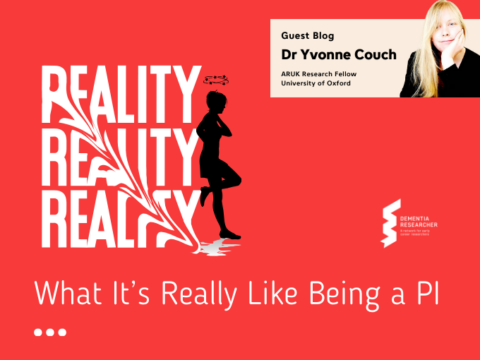In this blogpost, I encourage early-career researchers (ECRs) in dementia research to build on their existing journal clubs or independent reading efforts to take the step towards publishing letters as part of their intellectual and professional development.
Thousands of ECRs across the world work to solve problems related to Alzheimer’s disease and dementia. As part of their scientific training, most ECRs take part in journal clubs. But as many time-strapped ECRs know, such clubs can feel like a distraction from wet lab work or writing up papers or a thesis. This need not be the case. Such journal clubs can serve as a democratic forum, wherever your lab might be, for engagement with the literature through individual or group writing of letters in leading dementia journals.
But what are letters to the editor, sometimes called Correspondence? They are short articles between 200 and 800 words, generally written in response to recent publications or on other relevant topics. They can be written in dementia journals offering the letter format, such as:
- The Lancet (Neurology, Healthy Longevity, Public Health, Regional Health…)
- Brain (for online-only publication)
- The British Medical Journal*
- Neurology*
- Journal of Alzheimer’s Disease (online-only publication).
- Journal of Prevention of Alzheimer’s Disease
- International Journal of Geriatric Psychiatry
- International Psychogeriatrics
- Journal of the American Geriatrics Society
- Aging Medicine
- Alzheimer’s and Dementia and its Open-Access sister journals, Alzheimer’s & Dementia: Translational Research & Clinical Interventions (TRCI), and Alzheimer’s & Dementia: Diagnosis, Assessment & Disease Monitoring (DADM). At the time of writing, there are no article processing charges (APCs) associated with publishing letters in TRCI or DADM, despite them being fully open-access journals.
*Note: For Neurology and the BMJ, the online “Response” format is used. For the BMJ, cogent and timely Rapid Responses to original research are published as stand-alone letters in the print journal. For Neurology, “Reader Responses” are posted, and the original authors reply. The Editors then choose the best letter-plus-author-response to publish in the “Editor’s Choice” section of “Disputes and Debates” in the print journal. A recent example of mine in Neurology was a response to research conducted at University College London by Harriet Demnitz-King and colleagues. In their study of the association between self-reflection and cognitive decline, I argued that the authors had neglected social determinants of health in their analysis. They replied to my letter and conducted further analyses with social determinants, and our exchange was published. This shows that letter writing can have a direct and fruitful impact on scientists’ practice.
Why might ECRs write letters, and how? Being an ECR is difficult. It can be a demotivating time due to economic, personal, and technical hardships. The ECR is also generally haunted by impostor syndrome, especially before the final PhD defense. Because letters can be written within hours rather than the days, weeks, or months of other formats, writing them and having them accepted for publication can be a vital source of validation and motivation during the ECR period, also allowing for visibility in leading journals. Such short pieces may have a surprising impact: for instance, the most influential paper in the recent history of Alzheimer’s research is a 1100-word paper describing the amyloid hypothesis published in 1992, which has been cited over 8000 times as of March 2023 and whose impact is arguably due in part to its brevity and clarity. Writing letters teaches the value of concision, active reading, and can also serve to highlight one’s own lab’s research output. Moreover, letters are democratic because they are accepted based on the quality of writing and the timeliness of the arguments made. Finally, as alluded to above, letters generally do not incur article processing charges (APCs), even in fully open-access journals (but do check this before submitting because it is not a universal rule!).
But what makes a good letter? I have argued elsewhere that a three-part structure is the clearest: first, adequately describe the original research and be as generous as possible, knowing how hard it can be to carry a study to publication; then, suggest the need to go further or take an overtly critical turn (as per a journal club); finally, suggest concrete solutions. The goal should be dialogue that raises a point without falling into extremes of flattery or condemnation. It is worth knowing that in many journals, the original authors will publish a reply to your letter. There are plenty of examples for inspiration in contemporary Alzheimer’s research, which has a long history of letter writing by eminent researchers on a variety of topics.
Nevertheless, it is vital that ECRs do not overburden themselves with letter writing, which should not be seen as a replacement activity for empirical work or writing up longer format papers or a thesis. From an ECR perspective, it is vital that the letter remains a tool that helps the writer in their development. It should not become a hindrance.
To finish, when I encouraged one ECR to write a letter, they replied that they couldn’t possibly be critical of other researchers as they were “only a PhD student.”
I conclude with my own personal example to dissuade other researchers from adopting this attitude. Once I had sent the manuscript of my doctoral thesis on Alzheimer’s research off for external review, I was overwhelmed with impostor syndrome, as I had few publications to my name and no postdoctoral research lined up. During one evening of fretting, I stumbled on a recent article written by key opinion leaders in Alzheimer’s research which I found problematic, and decided to write a letter in response to it. When it was accepted, I started to believe that I actually hadn’t spent the last four years in utter vain. I then wrote more letters, and had a total of three accepted before my successful PhD viva on December 6th, 2021. I went on to have over 20 letters published or accepted in 2022, three in the BMJ, three in Neurology, and three in Alzheimer’s and Dementia. Publication of these letters led to an increase of my confidence and visibility, leading to invitations to collaborate on longer articles, and ultimately helped me to strengthen my CV and secure university funding for further research. Most importantly though, I stand behind the content of these letters and am proud of these contributions to the literature on Alzheimer’s. I encourage other ECRs in dementia research to build on their existing journal clubs or independent reading efforts to take the step towards letter writing as part of their intellectual and professional development.

Dr Timothy Daly
Author
Dr Timothy Daly is currently a Bioethics Training Programme Coordinator at the Latin American Faculty of Social Sciences (“FLACSO“) Argentina; and holds a position at The Sorbonne, Paris, France. His research explores ethics in Alzheimer’s Disease: How can we do better research? Outside work he writes poetry, speaking four languages and is working on learning another four. His motivation to work in dementia stems from his seeing his grandmother live with Vascular Dementia and wanting to to help.

 Print This Post
Print This Post




